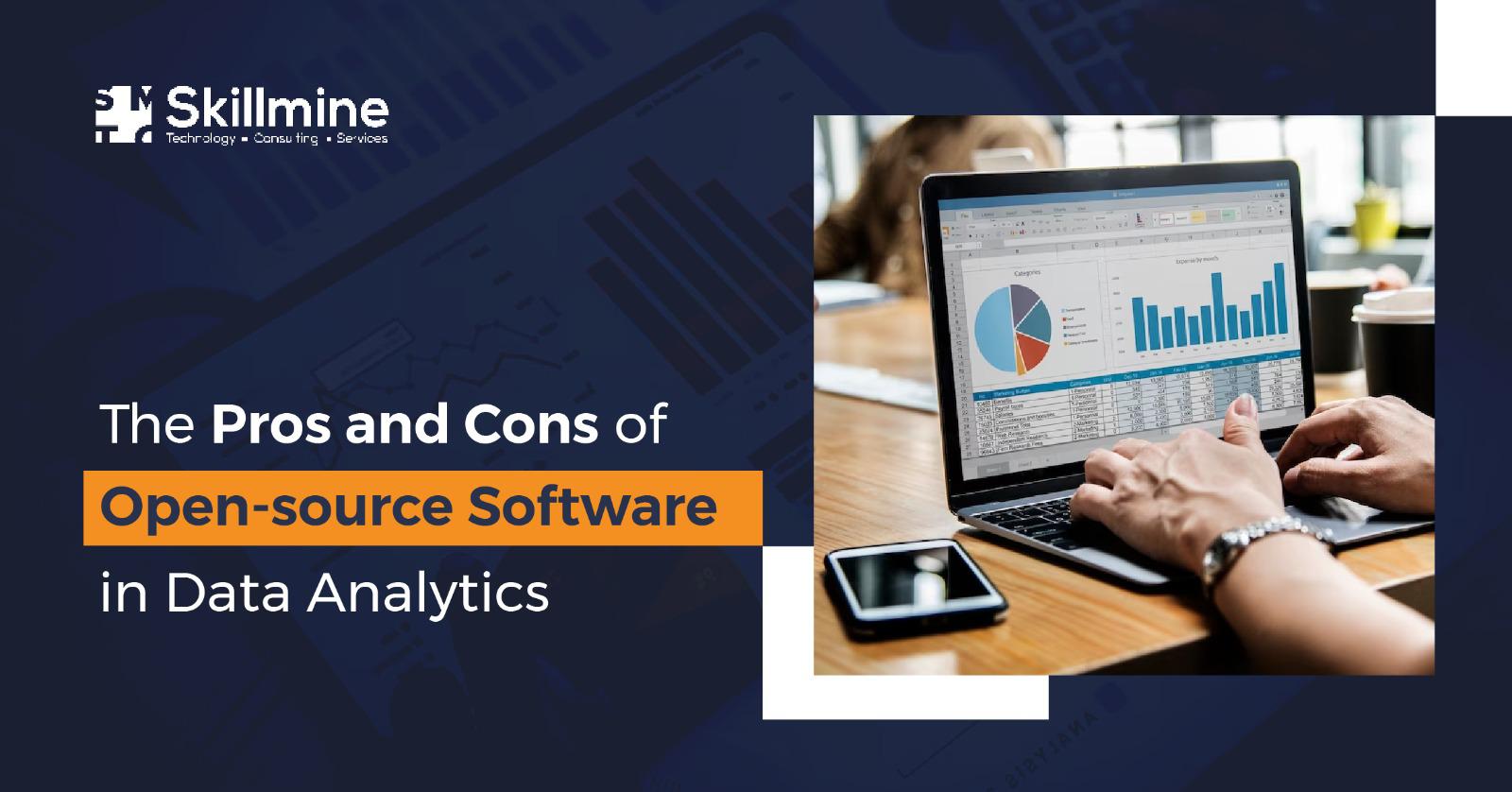Data analytics has become an essential part of modern business operations. With the increasing need for data-driven decision-making, companies are constantly seeking software solutions that can handle their data needs. One option that many organizations prefer is open-source software. According to a recent survey by Black Duck, over 78% of businesses use open-source software for data analytics.
While there are many benefits to using open-source software, there are also some drawbacks that need to be considered. In this blog, we’ll explore the pros and cons of open-source software in data analytics and help you decide if it’s the right choice for your organization.
History of Open-Source Software
The roots of open-source software can be traced back to the early days of computing, when pioneers like Richard Stallman laid the groundwork for the open-source movement.
In the 1970s and 1980s, proprietary software dominated the software industry, with companies tightly controlling access to source code and imposing strict licensing terms. However, this model stifled innovation and limited the ability of developers to modify and improve software to suit their needs.
In response to these constraints, Stallman founded the Free Software Foundation (FSF) in 1985, advocating for the creation of software that could be freely distributed, modified, and shared. Stallman’s GNU project aimed to develop a free and open-source Unix-like operating system, laying the foundation for the modern open-source ecosystem.
The 1990s saw the rise of Linux, an open-source Unix-like operating system kernel developed by Linus Torvalds. Linux quickly gained popularity among developers and enthusiasts, offering a free alternative to proprietary operating systems like Windows and MacOS. Its success demonstrated the viability of the open-source development model and inspired a new generation of developers to embrace collaborative software development.
The term “open source” was coined in 1998 when a group of software developers gathered at a historic meeting at the Foresight Institute in Palo Alto, California. The Open-Source Initiative (OSI) was formed to promote the open-source development model and advocate for the adoption of open-source licenses.
Throughout the 2000s, open-source software continued to gain momentum, with projects like Apache, MySQL, and Mozilla Firefox becoming household names. These projects demonstrated the power of collaborative development and the potential of open source software to rival proprietary alternatives in terms of performance, reliability, and functionality.
In recent years, the open-source movement has continued to evolve and expand, with organizations and governments around the world embracing open-source software as a cost-effective and flexible solution for their IT needs. Today, open source software powers some of the world’s most critical infrastructure, from web servers and databases to operating systems and mobile platforms. The principles of open source development – transparency, collaboration, and community-driven innovation – continue to drive the evolution of technology and shape the future of software development.
History of Open-Source Software
The roots of open-source software can be traced back to the early days of computing, when pioneers like Richard Stallman laid the groundwork for the open-source movement.
In the 1970s and 1980s, proprietary software dominated the software industry, with companies tightly controlling access to source code and imposing strict licensing terms. However, this model stifled innovation and limited the ability of developers to modify and improve software to suit their needs.
In response to these constraints, Stallman founded the Free Software Foundation (FSF) in 1985, advocating for the creation of software that could be freely distributed, modified, and shared. Stallman’s GNU project aimed to develop a free and open-source Unix-like operating system, laying the foundation for the modern open-source ecosystem.
The 1990s saw the rise of Linux, an open-source Unix-like operating system kernel developed by Linus Torvalds. Linux quickly gained popularity among developers and enthusiasts, offering a free alternative to proprietary operating systems like Windows and MacOS. Its success demonstrated the viability of the open-source development model and inspired a new generation of developers to embrace collaborative software development.
The term “open source” was coined in 1998 when a group of software developers gathered at a historic meeting at the Foresight Institute in Palo Alto, California. The Open-Source Initiative (OSI) was formed to promote the open-source development model and advocate for the adoption of open-source licenses.
Throughout the 2000s, open-source software continued to gain momentum, with projects like Apache, MySQL, and Mozilla Firefox becoming household names. These projects demonstrated the power of collaborative development and the potential of open source software to rival proprietary alternatives in terms of performance, reliability, and functionality.
In recent years, the open-source movement has continued to evolve and expand, with organizations and governments around the world embracing open-source software as a cost-effective and flexible solution for their IT needs. Today, open source software powers some of the world’s most critical infrastructure, from web servers and databases to operating systems and mobile platforms. The principles of open source development – transparency, collaboration, and community-driven innovation – continue to drive the evolution of technology and shape the future of software development.
Significance of Open-source software
Open-source software has revolutionized the way data analytics is done – it’s cost-effective, customizable, and transparent, and it’s a popular choice for businesses of all sizes looking to streamline their data analytics processes.
One of the biggest benefits of open-source data analytics software is its flexibility and customization. Businesses can make it fit into their specific needs, allowing them to be more agile and innovative in their data analytics operations. Additionally, the large and active community behind many open-source data analytics software projects means that businesses can access a wealth of knowledge and expertise, as well as ongoing development and support.
Open-source software is also known for its greater transparency and security, as the source code is available for public review and audit. This makes identifying and addressing potential security issues easier, reducing the risk of data breaches and other cybersecurity threats.
While open-source software offers many benefits, it also brings a few challenges. These include the limited official support, potential complexity, and the risk of integration issues with proprietary software. It’s important for businesses to carefully consider their specific needs and requirements when deciding whether to use open-source data analytics software.
Ultimately the importance of open-source software in data analytics cannot be overstated. Its cost-effectiveness, flexibility, and transparency make it an attractive choice for companies and organizations looking to stay ahead in the rapidly evolving world of data analytics.
Evaluating Open-source software
Pros of Open-source Software in Data Analytics
Data analytics can be expensive. However, open-source software saves you money while getting the job done. With its low cost, flexibility, and vibrant community, open-source software has become a game-changer in data analytics. Here we’ll explore the pros of open-source software in data analytics and show you how it can help your business thrive
1. Free to use and distribute
Using open-source software for data analytics has several benefits. The fact that it is free to use, and share is undoubtedly a benefit. This implies that no license is required to utilize it, and it is perfect for individuals or small enterprises that might not have the funds for commercial software.
2. Secure and reliable
Compared to proprietary software, open-source software is frequently safer and more trustworthy. This is because open-source software is often created by a community of developers capable of swiftly identifying and correcting security flaws. Furthermore, open-source software is more likely to be subjected to independent security assessments than proprietary software. As a result, it can give more security and dependability for data analytics.
3. Flexible
Open-source software is more adaptable and flexible than proprietary software, so it’s an excellent choice for data analytics. Modularity and a permissive license make it easy to extend and customize, and this flexibility is significant for data analytics, which is constantly changing and evolving. Open-source software can easily be adapted to new technologies and trends, whereas proprietary software often requires considerable investment to keep up with the latest changes.
4. Sustainable
Due to its greater adaptability and customizability, open-source software is more sustainable. The open-source community may collaborate to provide the necessary updates or improvements to data analytics. Also, by working together, the programme is made to be trustworthy and safe. The open-source community is also vibrant and helpful, with various online forums where users may post queries and seek assistance from other users.
5. Built on the work of others
Open-source software is based on the contributions of others. This implies that developers may improve their products by building on the work of others. This also means that customers may report any issues with the programme and get them resolved as soon as possible. Also, as the community contributes new features, it is constantly evolving.
6. Fast and Innovative
Since it instantly enables developers to exchange concepts and code, open-source development is swift and inventive. This makes it possible for more individuals to participate in the project, leading to a better result. Also, due to its increased user testing, open-source software is frequently more dependable.
7. Publicly Available
The public availability of source code is one advantage of open-source software. This entails that anybody may review and edit the code, which can result in high-calibre software. Moreover, it enables developer cooperation to enhance the code jointly.
Cons of Open-source Software in Data Analytics
Given the benefits of this type of software, it’s essential to consider the possible drawbacks. For one, it can be prone to security issues, making it difficult to use. Also, finding good recommendations and reviews can be challenging, implying you might not get the best quality software.
1. Security risks
Due to the open-source nature of the code, open-source software is frequently more susceptible to security risks. This makes it simpler for hackers to identify and use vulnerabilities in the system.
2. Complex installation
Another drawback is that open-source software might be difficult to install and configure. This is often the result of a shortage of developers and documentation.
3. Limited Functionality
In general, open-source software provides less functionality than commercial versions. This might be an issue if you want special features that the open-source version does not offer.
4. Lack of support
The absence of assistance is one of the open-source software’s main drawbacks. To locate a solution, you will need to rely on internet discussion boards and local assistance.
5. Lack of updates
Developers of open-source software don’t always release updates regularly. This can result in flaws and security holes that are never repaired.
Factors to consider while using open-source software
It might be challenging to decide which data analytics software to use because so much of it is available. Consider the following while selecting open-source software for data analytics:
- Functionality
- Ease of use
- Cost Community
Popular Open-source Software in Data Analytics
Arcadia Instant: Arcadia Instant is a desktop visual analytics tool offering visualization features sourced from Arcadia Data. This open-source software boasts connectivity with Confluent KSQL for visualizing Apache Kafka topics, and it seamlessly links with AWS Athena, Google BigQuery, and Snowflake, facilitating an effortless initiation into native cloud visualization.
BIRT: BIRT, an acronym for Business Intelligence and Reporting Tools, is an open-source software initiative in data analytics designed to serve as a robust platform for crafting data visualizations and reports. Particularly tailored for integration into rich client and web applications, especially those rooted in Java and Java EE, BIRT is recognized as one of the leading projects within the Eclipse Foundation.
Dataiku DSS: Dataiku DSS, standing for Data Science Studio, emerges as a collaborative data science software platform meticulously designed to cater to teams comprising data scientists, data analysts, and engineers. This platform facilitates the exploration, prototyping, development, and delivery of personalized data products. Users can visually profile data at each analysis stage, and the interactive exploration feature encompasses over 20 different chart types.
Helical Insight: Helical Insight is an open-source business intelligence framework that prioritizes developer friendliness and is constructed using Java. This tool empowers users to analyse their existing datasets and embed the results. Moreover, it provides the flexibility to build plugins and introduce functionalities through HTML and Java development as needed.
Tableau Public: Tableau Public, a complimentary service, enables individuals to share interactive data visualizations on the web. The visualizations, known as “vizzes,” can be seamlessly embedded into web pages and blogs shared through social media or email and made downloadable to other users. Upon publishing a workbook to Tableau Public, the visualization becomes instantly accessible to a global audience.
Grafana: Grafana, an open-source data analytics platform, enables users to monitor and analyze metrics across various applications and databases. It provides alerts for specific events and real-time insights into external systems.
Redash: Redash, another popular open-source software, empowers organizations to adopt a data-driven approach. The software offers connectivity to diverse data sources, visualization, data sharing, and democratized access within companies. Users can customize and enhance features without concerns about lock-ins, query various data sources, and collaborate effectively.
KNIME: First introduced in 2006, KNIME’s Analytics platform has gained rapid adoption in the open-source community, companies, and software vendors for data science creation. The intuitive software simplifies data understanding through visual workflows created using a drag-and-drop graphical user interface. Users can model analytical steps, control data flow, and ensure up-to-date work.
RapidMiner: RapidMiner, a cloud-based suite, offers an integrated end-to-end analytics platform with automation features, in-database processing, and real-time scoring. The open-source product supports preprocessing, clustering, predictive modeling, and transformation models.
RStudio: RStudio serves as both an open-source data analytics tool and an integrated development environment suite for the R coding language. This tool facilitates the creation of interactive reports, documents, web applications, and other types of reporting. Leveraging in-memory processing and integrations, RStudio parses big data efficiently.
Final Thoughts
Open-source software for data analytics can be a cost-effective and flexible option, but it may lack the features and support of commercial software. However, its rapid development and widespread use make it a popular choice for organizations of all sizes. Ultimately, the decision to use open-source software in data analytics is based on the organisation’s specific needs.





